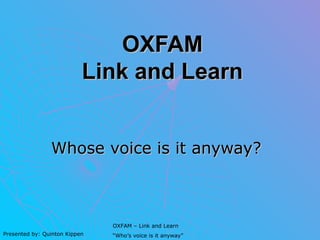Whose voice is it anyway?
- 1. OXFAM Link and Learn Whose voice is it anyway? OXFAM â Link and Learn Presented by: Quinton Kippen âWhoâs voice is it anywayâ
- 2. Voices ïĩ Civil society organizations often claim representation â i.e. that they articulate and amplify the voice of those who cannot speak for themselves. OXFAM â Link and Learn Presented by: Quinton Kippen âWhoâs voice is it anywayâ
- 3. ïĩ Government and others often accuse civil society of instigation and of âcreating issuesâ and âmaking things out to be bigger than they areâ. OXFAM â Link and Learn Presented by: Quinton Kippen âWhoâs voice is it anywayâ
- 4. ïĩ With the rise of social movements and the sporadic outbreaks of autonomous local actions does civil society still have a role? OXFAM â Link and Learn Presented by: Quinton Kippen âWhoâs voice is it anywayâ
- 5. ïĩ Here are a few critical questions for this session, which will examine civil societyâs democratic practice and the role it plays in shaping the issues of the day. OXFAM â Link and Learn Presented by: Quinton Kippen âWhoâs voice is it anywayâ
- 6. Questions ïĩ Who do we work with and why do we work with them? ïĩ Who leads and who follows? ïĩ Who decides what issues are priority? OXFAM â Link and Learn Presented by: Quinton Kippen âWhoâs voice is it anywayâ
- 7. Process ïĩ Divide into groups no larger than 5 participants per group. ïĩ You will have 45 minutes to discuss the questions and capture points on paper provided. OXFAM â Link and Learn Presented by: Quinton Kippen âWhoâs voice is it anywayâ
- 8. Feedback ïĩ Reflection, questions and comments







